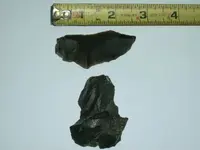The top image is very thin and translucent on the edges. It is shaped like a bowie knife. It is fluted at the hafting area. The back is smooth and concave. The bottom image is translucent on the edges. It has a possible graver tip on the right and spokeshave on both sides.
Amazon Forum Fav 👍
Attachments
Upvote
0





